2023 alone was enough to show us how customer support practices can change over a year.
Artificial intelligence advancements, stronger hybrid work setups, new automation technology, and ever-evolving customer needs are just some of the new additions that marked how we interact with customers.
Some of these trends are here to stay.
To help you remain on top of everything, we’re digging into the most impactful customer service statistics that are bound to make 2024 a more challenging, yet exciting year.
How we chose these stats:
We picked only the most relevant customer service benchmarks based on how often customer support teams encounter these challenges as well as accuracy and freshness.
These stats are organized according to the most popular trends and insights you’re likely to bump into, starting with popular technology innovation updates. Towards the end of our rundown, we’re also looking at what’s likely to influence customers as well as agent performance in 2024.
How to use these stats:
Use these customer service statistics to better plan how you’re going to improve the way you run customer service efforts within your organization. Each new trend or insight will help you see exactly how customer service is going to change in the future and what you can do to improve the service you provide. Remember that these customer service stats only reflect what most organizations are doing or planning to do. You should adapt these trends and expectations to your own company’s goals and policies.
Customer support teams will be more reliant on AI
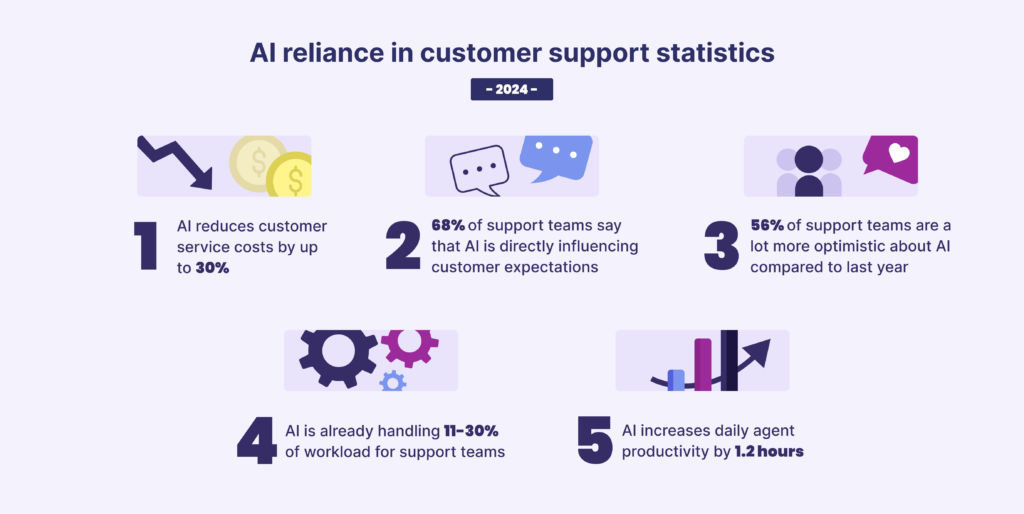
AI can reduce your customer service costs by as much as 30%.
AI systems help you scale and handle higher volumes of customer interactions simultaneously. This scalability is particularly valuable during peak times or periods of increased customer demand, reducing the need for additional human resources.
On top of this, it can help provide instant responses to customer queries, leading to faster issue resolution and lower wait times. This efficiency can contribute to lower operational costs by reducing the time required to address customer concerns.
And the results are already in!
68% of support teams observe that AI is directly influencing customer expectations. The same Intercom study notes that 56% of support teams are also considerably more optimistic about AI compared to the previous year. Most also report that 11-30% of their support volume is handled by artificial intelligence technology at the moment.
AI-enabled issue classification and automatic routing of incoming customer communications contribute to a daily increase in contact center agents’ productivity by 1.2 hours.
Investments in artificial intelligence are even more significant
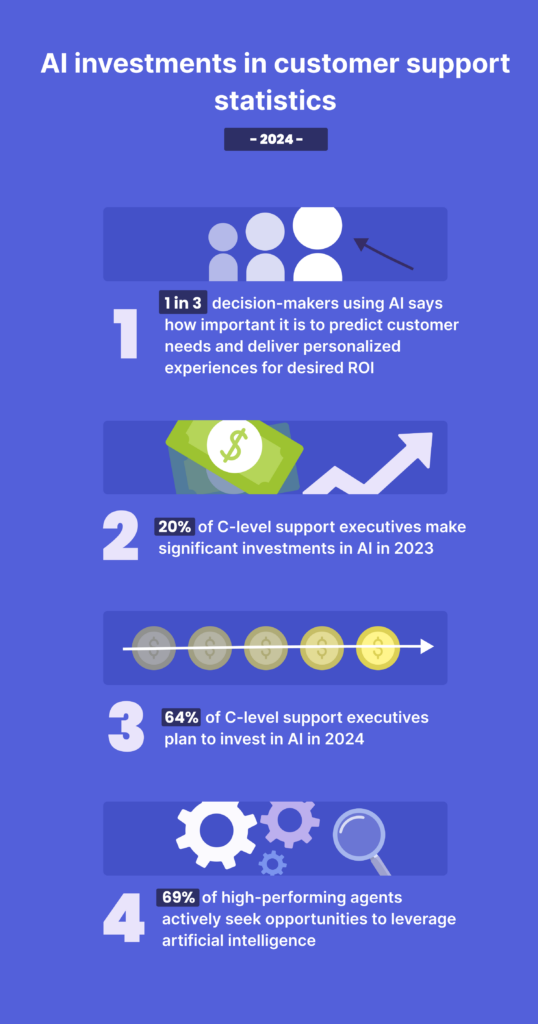
One out of every three decision-makers integrating AI underscores the importance of predicting customer needs and delivering personalized experiences as crucial for achieving your desired return on investment.
So AI investment is increasing, with 20% of C-level support executives making significant investments in AI during 2023. This upward trajectory is expected to continue with 64% of C-level support executives expressing plans to invest in AI in 2024.
Particularly, support teams are looking to invest in chatbots, customer behavior analysis, and knowledge base enhancement for self-service improvements.
Agents are in it too.
With high-performing service agents, 69% actively seek opportunities to leverage artificial intelligence, while their underperforming counterparts amount to only 39% doing the same.
Chatbots are gaining momentum (and they’re here to stay)
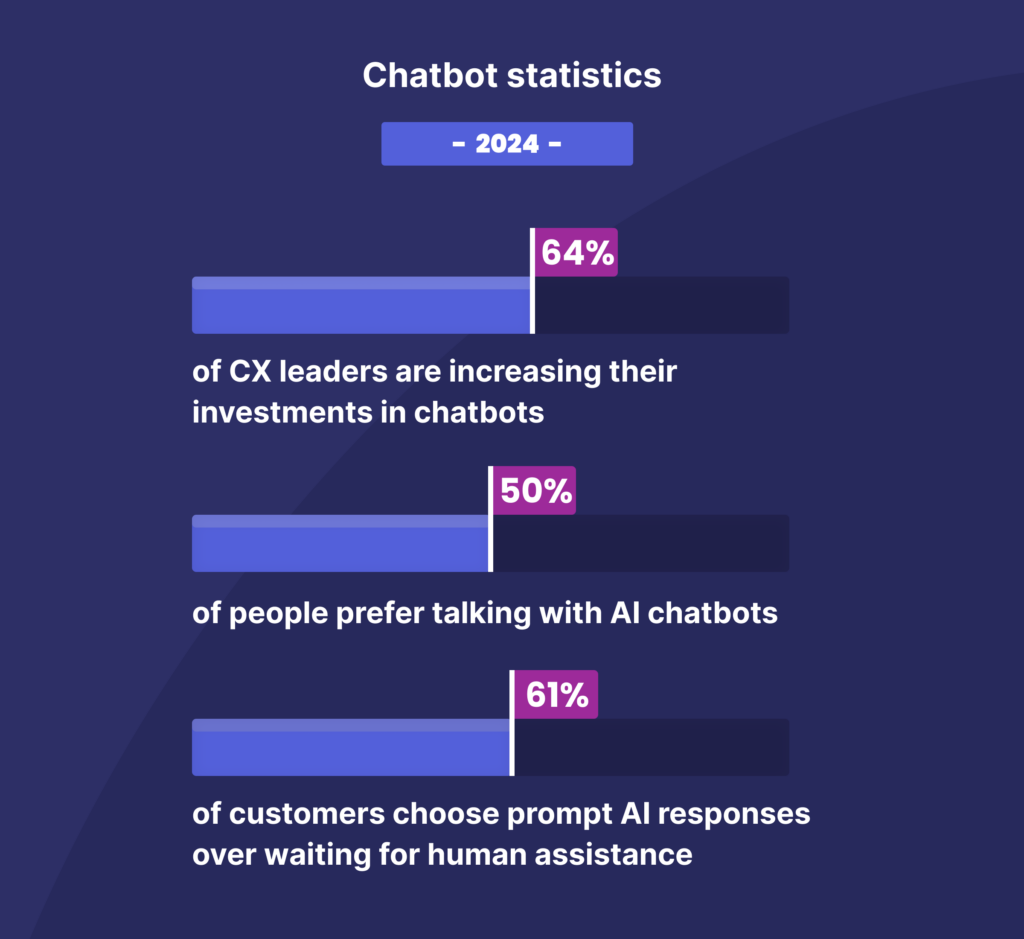
64% of CX leaders are bumping up their investments in chatbots.
AI-powered chatbots can provide round-the-clock support, addressing customer queries and issues at any time, which is often challenging for human agents to achieve consistently.
Well-designed chatbots can enhance the overall customer experience by providing accurate information, quick solutions, and personalized interactions, leading to increased customer satisfaction.
As many as 50% of people actually prefer talking with AI chatbots. Another Intercom study revealed similar numbers with 61% of customers choosing the prompt responses of AI over waiting for assistance from a human customer support representative.
Self-service stands its ground
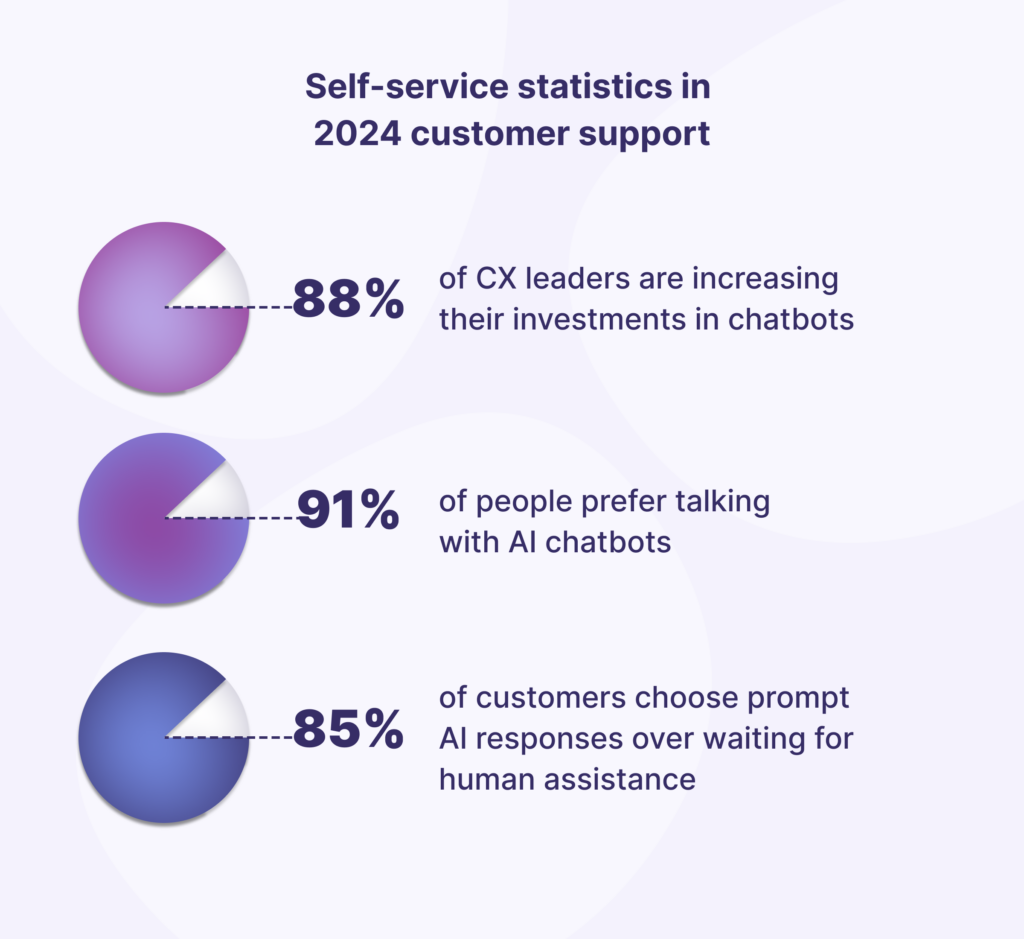
In 2024, 88% of people simply expect a brand to have a self-service portal. An impressive 91% indicate a willingness to utilize a knowledge base if it fulfils their requirements, highlighting the importance of meeting customer needs through accessible and user-friendly information resources.
This further underscores the growing significance of empowering individuals to find solutions independently within the evolving landscape of customer service expectations. It’s important to note that self-service comes only second to calls and emails when it comes to handling general issues but does tend to fail to solve complex problems.
As the use of self-service technology continues to grow, companies are particularly relying on customer portals, and mobile applications to offer this type of support. 85% of companies provide customers with at least one of these self-service opportunities.
Automation has its place in any customer service team
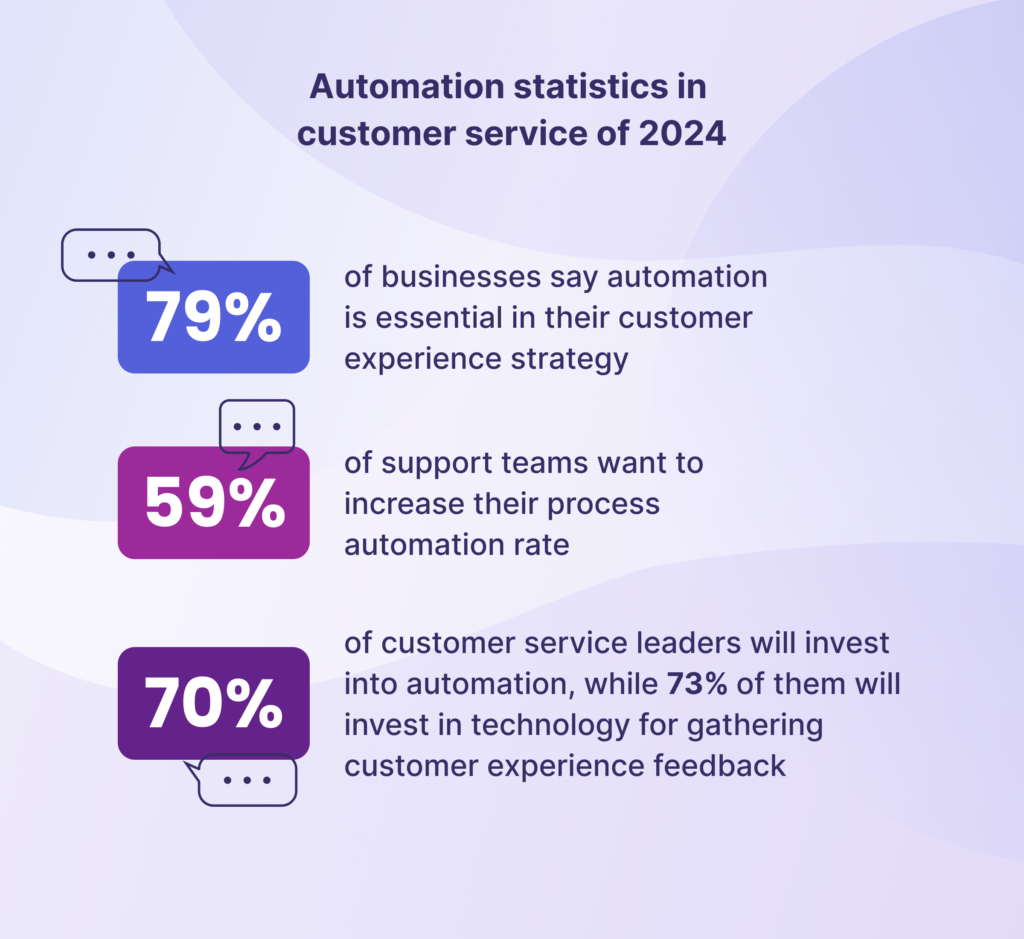
79% of businesses consider automation to be essential in their customer experience strategy.
So most teams have already started to implement automation to some extent. Automatic assignments, for instance, now mean that more inquiries are attributed to agents automatically by taking into account their skills or pre-decided rules.
Deloitte further reveals that for 59% of support teams, increasing their process automation rate remains a core priority alongside other goals such as improving customer satisfaction, improving self-service channels, and reducing response times.
About 70% of customer service leaders also intend to make investments to enhance automation, while 73% of them plan to invest in technology for gathering customer experience feedback.
New priorities to be expected
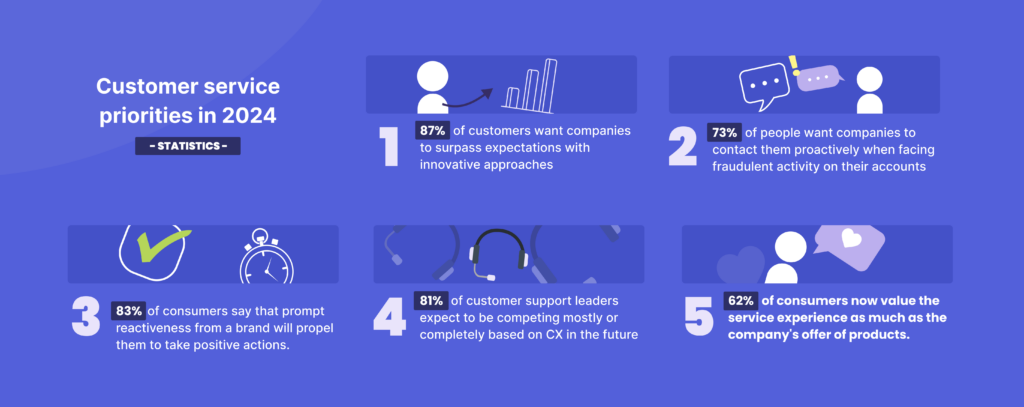
Surprise! There are a couple of new priorities your customer support team should keep an eye on.
In particular, this year, customers are looking for more proactiveness. A whopping 87% of customers want companies to surpass expectations and establish new benchmarks in customer service through innovative proactive approaches.
This is especially valid in challenging or tricky scenarios. For instance, 73% of people want companies to contact them proactively when facing fraudulent activity on their accounts. And 83% of these consumers say that this type of reactiveness from a brand will propel them to take positive actions.
Customer experience is also what’s likely going to be a game changer in the future for every organization. Not surprisingly, statistics from Gartner show that 81% of customer support leaders expect to be competing mostly or completely based on CX in the future.
Also important to note: 62% of consumers have reorganized their priorities and now value the experience a company provides as much as its offer of products and services.
Better customer retention depends on an organization’s adaptability
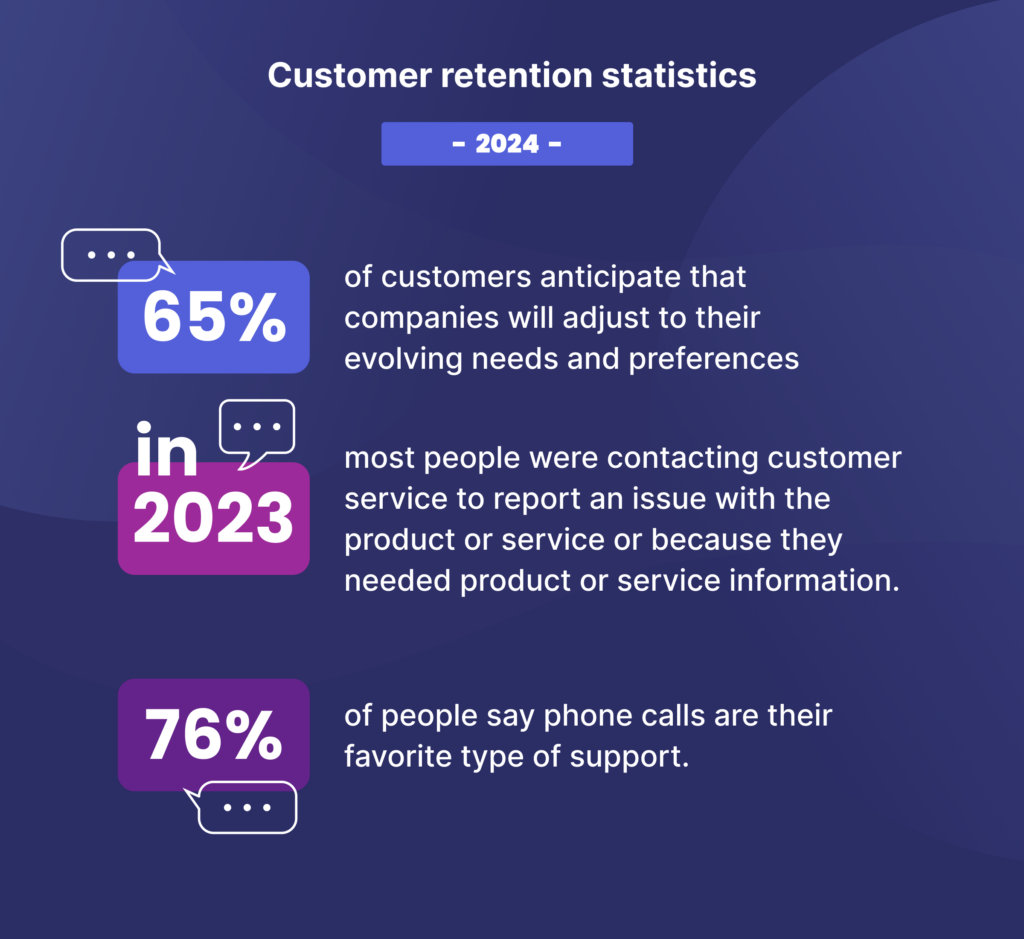
65% of customers anticipate that companies will adjust to their evolving needs and preferences and stop treating them like a number. That’s one fundamental thought to remember when interacting with customers.
It’s worth remembering that what customers care about and why they reach out to a support service in the first place is always changing. Thus, you should consider these aspects when interacting with customers and prospects.
According to Deloitte, in 2023, for example, people were contacting customer service mainly to report an issue with the product or service or because they needed product or service information.
The same Deloitte study reveals that companies must stay flexible when it comes to the contact channel strategy they’re using. This said, organizations are now required to use both traditional and digital channels to get in touch with their customers depending on the exact needs a customer has at any given time.
For instance, while customer support representatives still rely on email (91% support it) and phone calls (89% support it) to offer support, other channels such as video calls (20% support it) or proactive SMS messaging (15% support it) are losing ground. Phone calls continue to be the favored customer service channel though with 76% of people opting for this type of support.
Agent engagement and productivity
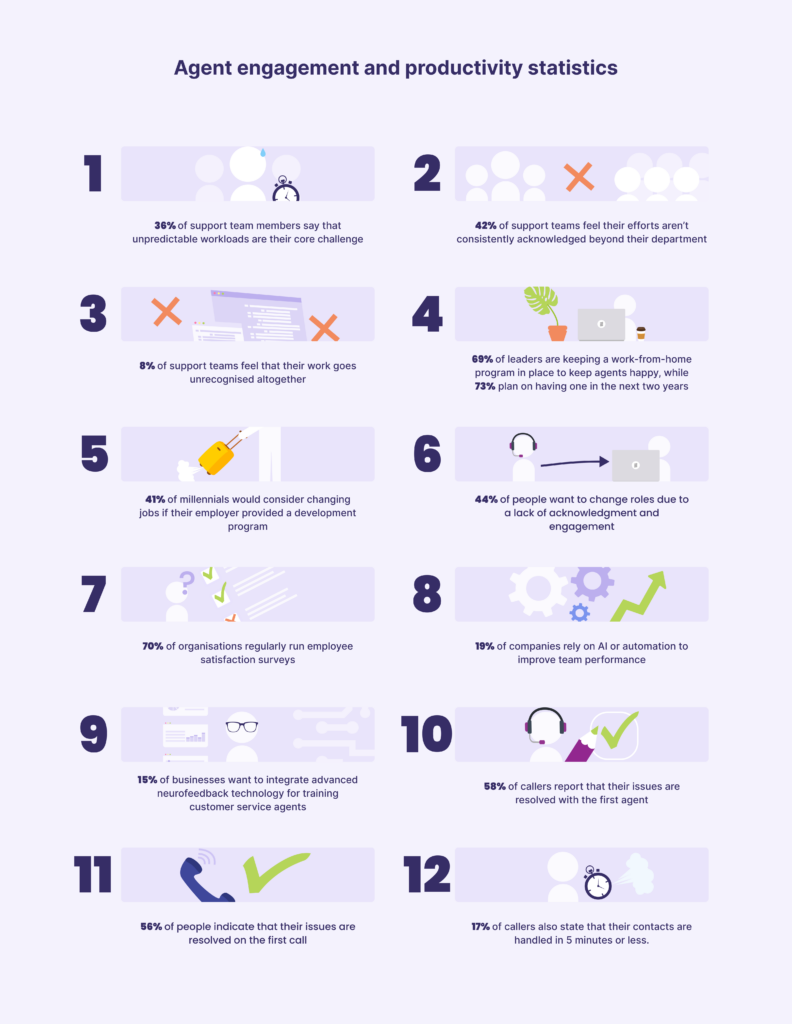
With times getting busier, agents are facing more challenges than ever:
36% of support team members say that unpredictable workloads are their core challenge. Customer support is always dynamic, with inquiries varying in volume and complexity throughout the day. This variability makes it challenging for support team members to anticipate and plan their work effectively.
With so many support teams understaffed and busy all the time, 42% of them perceive their support team’s efforts aren’t consistently acknowledged beyond their department, while 8% feel that their work goes unrecognized altogether.
Agent retention and engagement play crucial roles in shaping and elevating the overall customer experience. When agents are motivated, satisfied, and committed to their roles, they are more likely to provide exceptional service to customers.
And leaders are staying flexible to what agents want. To prevent staff shortages (and improve agent happiness levels across the organization), 69% of leaders are keeping a
work-from-home program in place, while 73% plan on having one in the next two years.
Another way to boost retention is by offering better training opportunities. 41% of millennials would consider changing jobs if their prospective employer provided a professional development program. All this as 44% attribute their wish to change roles to a lack of acknowledgment and engagement within their current workplace.
But what else are companies doing to keep their agents happy?
- 70% of organizations regularly run employee satisfaction surveys to get a grasp of how their agents really feel
- 19% of companies rely on innovative technology that uses either AI or automation to improve team performance
- 15% of businesses want to integrate advanced neurofeedback technology for training customer service agents to enhance empathy and emotional intelligence
The results?
A CFI Group study reveals that 58% of callers report that their issues are resolved with the first agent, resulting in a Contact Center Satisfaction Index (CCSI) of 78.
56% of people indicate that their issues are resolved on the first call, achieving an average CCSI of 81 which diminishes when multiple contacts are necessary to address the issue.
17% of callers also state that their contacts are handled in 5 minutes or less, leading to a CCSI of 82. Beyond the 10-minute mark, CCSI experiences a sharp decline.
Customer expectations are at their peak
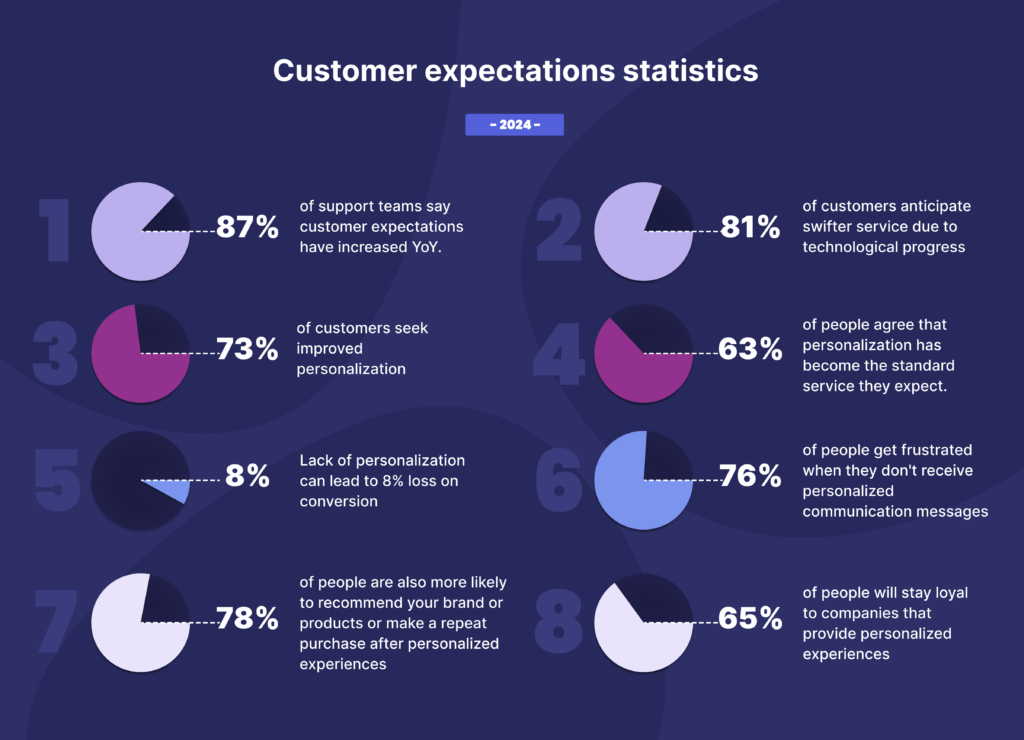
87% of support teams say customer expectations have increased year on year. Over
two-thirds of them also note these expectations have been directly influenced by AI while new advancements will only accelerate customers’ expectations of faster response times.
Advancements in technology, such as generative AI and automation, offer you the chance to provide better and more extensive personalization. Salesforce reports that 81% of customers anticipate swifter service due to technological progress and 73% seek improved personalization.
So personal is still the way to go.
63% of people agree that personalization has become the standard service they expect.
That means no more shortcuts even if you’re using automation technology. Otherwise, Trustpilot observes you could leave people feeling frustrated with irrelevant messaging or lose out on conversion rates as high as 8% (when incorporating personalization into the customer experience process).
Non-personalized communication on the other hand puts your business at risk of losing loyal customers. 76% of people get frustrated when they don’t receive personalized communication messages. The same McKinsey report reveals that 78% of people are also more likely to recommend your brand or products to other people while the same percentage of consumers is also more likely to make a repeat purchase.
Salesforce further adds to these customer service statistics by highlighting that 65% of people will stay loyal to companies that provide personalized experiences.
So what’s next for you?
Start by making a list of your current challenges to understand what’s working and what’s not. This lets you quickly note where you should improve. Using the customer service statistics above you’ll be able to prioritize these challenges based on exactly what consumers need.
For instance, if you’re finding it difficult right now to better connect and resonate with your audience, that’s a clear sign that you might want to look into better personalization. Similarly, if you’re looking to speed up ticket resolution time or just make your agents’ life easier, you want to look into a digital solution that provides automation and artificial intelligence capabilities.
Using Kaizo’s customer support operations platform you can leverage automation and AI for quality assurance and keeping your workforce engaged. Start by training Kaizo’s innovative AI assistant Samurai to know how to QA rate tickets up to your standards. Your QA raters will only need to examine the notes generated by Samurai and make adjustments if necessary.
What else can Kaizo do?
- Use Kaizo’s AI to transcribe and condense tickets automatically, enabling QA experts and team leads to make well-informed decisions and enhance the efficiency of their evaluation process.
- Automatically calculate Customer Sentiment to enhance the accuracy of your customer sentiment analysis.
- Systematically and impartially evaluate every interaction between your agents and users, using these empathy scores to support agents in identifying opportunities for enhancing their soft skills.
- Use Kaizo Missions to enhance goal configuration through AI-driven suggestions and create customized, challenging tasks for agents.
- And many more ways of running QA and keeping your team productive and engaged!
Try Kaizo for free on Zendesk or Salesforce to turn your support workforce into your leading strategic advantage! Or book a demo with us to see how Kaizo can enhance your workflows after just a few clicks!


